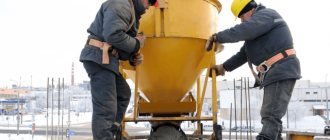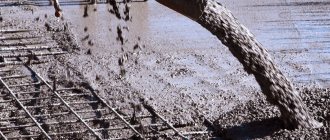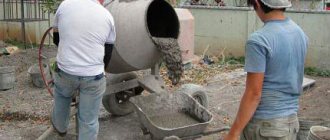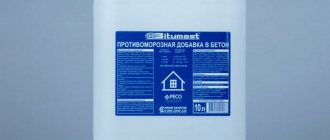Due to various circumstances, construction deadlines may change, for example, work that requires suitable weather may have to be rescheduled. First of all, this applies to pouring monolithic concrete structures. This material changes its setting speed depending on the ambient temperature. In a closed space, you can create the necessary microclimate so that the hardening process is uniform. For outdoor work, you need to know the optimal temperature for pouring concrete outdoors.
Features of strength gain of concrete structures
To clarify at what air temperature the cement mixture can be poured, you need to understand the hardening process. In the finished solution, a reaction occurs between the components of cement and water - hydration. The process takes place in two stages:
- setting with the participation of SZA aluminates. Inside the concrete, needle crystals are generated that bond with each other. After 6-10 hours, a kind of skeleton of the mixture is formed;
- hardening with the participation of clinker minerals C3S and C2S. During concrete hardening, a silicate finely porous mass of small crystals is formed.
Interesting to know! At low temperatures, the water in the foundation becomes ice, which leads to the end of hardening and setting.
The danger of the influence of sub-zero temperatures on the state of the mixture
The rate of hydration reactions and strength gain of concrete is tied to the ambient temperature. When it is lowered from +20 to +5 degrees, the hardening time increases 5 times. The hardening process is even slower if it gets cold outside.
Freezing water at subzero temperatures causes it to expand. Next, there is an increase in pressure inside the mixture, which causes the disintegration of the crystal lattice. The consequence of the reaction is the destruction of the foundation and deterioration of solidity properties due to the enveloping of aggregates in ice.
Important! After the liquid thaws, the hardening process is restored, but the quality of the concrete will be worse - the reinforcement peels off and the monolith cracks.
What air temperature is acceptable for the solution?
Experts have found out at what optimal air temperature it is necessary and possible to pour ready-made concrete. It is better to carry out foundation construction work in the range from +5 to +15°. Outdoor temperature conditions ranging from +5 to minus 3° stipulate that freshly laid M200 concrete weighing 240 g/m3 should not be lower than +5 degrees.
On a note! When using less cement, the optimal internal temperature of the composition is +10°.
Protection from precipitation and frost
Monitoring precipitation is quite simple: follow the weather forecast and choose days for pouring when no rain is expected. There must be at least three days in reserve. If precipitation takes you by surprise, you need to quickly cover the “ribbons” with oilcloth. It is more difficult to protect from frost, and the procedure will be expensive. Some people prefer to simply cover the base - this is a cheap and ineffective way. Next come special anti-frost additives. If you buy high-quality additives, concrete will normally gain strength even at -15 degrees.
This table will help you choose the appropriate curing time for the concrete mixture.
The best option is to provide the concrete with good heating. Today, a special cable is used for these purposes. It must be placed on top of concrete and covered with heat-insulating material. It is not possible to carry out this procedure on your own, since specialists must calculate the power consumption, suitable length and other parameters. And you can’t overheat the mixture.
Technology and features of pouring in autumn
At what average summer temperature should construction begin? The warm season - from +15 to +30 degrees is suitable for construction work. Pouring concrete in summer is acceptable. The only condition is to protect the freshly laid monolith from rain.
Choosing the right time
In the fall, the weather is unpredictable, so it is important to know at what temperature you can pour concrete in the fall.
The optimal air temperature is from +20 to +5°, so it is recommended to start laying the foundation in September-October before frost. In the process of arranging the foundation, it is important to consider to what point on the thermometer the work needs to be completed before the cold snap. It should be +10 degrees Celsius. The concrete mass gains strength within 1 month. Before frost, it is recommended to make a shelter, and in the first two days, protect the mixture with film from rain.
Advice! Before pouring your foundation in the fall, check the weather forecast.
Factors influencing dough setting in autumn
Pouring a monolith will be of high quality if you take into account several points:
- air temperature. At what temperatures can concrete be poured in the fall to start building a house? The normal value is plus 16°. During this period, the solution hardens slowly, which ensures the quality of construction. Frosts occur at the end of October, so it is better to start construction in mid-September;
- humidity characteristics. Damp weather and wet soil promote the curing process. Freshly laid mortar does not need to be regularly sprayed with water, and slow drying ensures increased strength;
- presence of precipitation. If you have figured out the optimal temperatures at which you can pour the foundation, then you need to take into account the presence of rain. Overmoistening of the monolith leads to the leaching of cement laitance;
- ground water level. In swampy areas there is less water in the fall, which makes it possible to make a pile foundation. You can check whether the water has risen by digging a trench. If water has risen in it, the foundation cannot be poured.
Important! If at least one factor does not comply, the structure will lose strength.
Recommendations for winter concreting
Due to its chemical composition, concrete at sub-zero temperatures is not able to maintain good quality.
If you want to lay the mixture in the cold, you should follow some rules:
- it is necessary to prepare auxiliary structures. It is necessary to clear the formwork from ice and sediment and heat the reinforcement structures and the bottom until the required temperature is reached. This will require heating elements;
- use of slab foundation. This makes it impossible to maintain the required temperature in icy cold weather. Experienced builders fill this type of foundation only when the mercury is above 0°C or slight frost;
- use of strip foundation as a base. Due to the possibility of performing the work in stages, this option is most suitable for the construction of housing in cold weather. It is better to create heating complexes for hardening concrete in certain areas;
- continuity of work. If the foundation must be poured in sections, each subsequent location must be filled before the first one sets;
- combination of methods. Practice shows that the best results can be achieved when using several methods of winter concreting.
Even despite all the accessibility of construction in the frosty season, it is necessary to remember that this entails extra costs of time, money and effort. Therefore, it is better to pour concrete in the warm season.
Is it possible to artificially increase the frost resistance of a solution?
To speed up the work and prevent destruction of the foundation, it is allowed to use anti-freeze agents, warm up the concrete or insulate it.
Types of additives
If the dosages of special products are observed, it is easy to predict at what extreme negative temperature the construction should be completed. It is permissible to continue work down to -25 degrees. Products are classified depending on their effect on the mixture.
Additives
Special liquid products for solution hydration in sub-zero temperatures. Used in conjunction with heating to accelerate hardening and setting reactions.
Antifreeze
Means that increase the activity of cement paste in any conditions:
- potash or substances based on salts of monocarboxylic acids. They increase the temperature range for working with concrete composition to -30 degrees, accelerating the hardening of the composition. The reinforcing frame is not subject to corrosion, there is no efflorescence on the surface of the monolith;
- sodium chloride - used to plasticize the Portland cement mixture, preventing thickening. Steel reinforcement may rust;
- sodium nitrite - suitable for all types of cements, except alumina. After adding the product, the mixture can be worked at low temperatures, but up to -15 degrees;
- sodium formate - involves the use of plasticizers. Without them, voids appear in the monolith due to the accumulation of salts.
On a note! Antifreeze prevents heating of the structure.
Setting accelerators
They are distinguished by the rapid release of heat, so the water temperature remains stable and the monolith heats itself.
Important! If the dosage of substances is not observed, there is a risk of corrosion of the reinforcing frame.
Heating methods
Warming up concrete is relevant if it requires pouring the foundation of a low-rise building. If you are wondering to what maximum level the temperature can be increased, this figure is 15-20 degrees. Antifreeze mixtures begin to be introduced at temperatures from -15 degrees. Now we will briefly consider options for electrical heating of concrete:
- A frame made of wooden beams is installed across the entire area of the building, on which a film tent is organized. Gas or electric guns are installed inside the structure. After the temperature rises, the devices maintain it throughout the concrete hardening cycle;
- wrapping the reinforcing frame with a heating cable before you start pouring the foundation. The electrics are turned on after the mixture is laid. In addition to the cable, you can use nichrome spirals or heating elements.
Important! In conditions of severe cold and soil freezing, the technique is ineffective.
Features of shelter and insulation
Using this method, once the outside temperature reaches 3–7 degrees, you can pour concrete.
How to pour concrete in winter at low temperatures
Sometimes construction work is carried out in winter. For example, when constructing a building on loose soils. Pouring concrete in winter is cheaper due to lower prices for work and materials. The disadvantage of working in cold weather is the long drying period. In addition to adding additives, there are methods of physically heating the mixture or structure.
Thermos method
Hardening of cement mortar is an exothermic reaction, as a result of which a large amount of heat is released. Thus, the poured solution heats itself. To increase the cooling time, the poured structure is covered with thermal insulation material. Even at temperatures well below 0°C, concrete has time to gain strength before it cools completely.
Initially, the solution temperature should not be lower than +10°C. When heated to 25-45°C, the result is much better.
To avoid destruction, at the beginning of the work a technological calculation is made, which takes into account the volume of the structure, the average daily temperature and heat loss.
Electric heating of concrete mixture
This method allows the mixture to be heated evenly, while its strength increases and its service life increases.
The method is based on the ability of cement to conduct electricity. The electrodes are mounted inside the solution and on the surface, and voltage is supplied from the transformer. The parameters depend on the brand of cement, air temperature, volume and shape of the structure.
Types of electrodes for heating:
- Stripes. Used to heat horizontal structures. They are metal strips up to 5 cm wide.
- Rod. Sections of reinforcement with a diameter of up to 12 mm are installed in rows. The distance between the rods is determined in practice.
- Strings. Used for vertical structures, they are reinforcement with a diameter of up to 15 mm and a length of up to 3 m.
The electrodes are placed in the poured solution according to the following scheme: no closer than 3 cm to the formwork, no closer than 10 cm to the technological seam, the distance between the electrode rods and the frame reinforcement rods is 5-15 cm, the minimum distance between the working elements is 20 cm.
A prerequisite for electric heating of the mixture is additional thermal insulation.
The electrodes are connected to a generator that supplies alternating current. Direct current cannot be used during heating, as it provokes electrolysis and water molecules are destroyed, and cement hydration does not occur.
It is not recommended to use a welding machine for heating, as it can quickly fail.
The electric heating method has a number of disadvantages:
- High costs for consumables (electrodes remain in the monolith).
- High energy costs (about 1000 kV per 3-5 m3 of solution).
- The need for additional calculations.
Steam heating of concrete in winter
The method is used at facilities where there is already a large volume of steam and insufficient electricity. The disadvantage of this method is large heat losses.
Steam is delivered to the solution through capillary formwork, as well as by launching steam into hothouses and steam jackets. The pressure and temperature of the steam depend on the grade of cement from which the concrete is made.
The jacket is the space between the formwork and the vapor-tight lining, through which heated, moist air circulates under pressure. The distance between the steam supply points is no more than 2 m. Jackets are used to heat vertical structures, as well as interfloor ceilings. Warming up in this way is uneven, with large heat losses.
A heater is a removable, portable structure that is used to heat the foundations and soles of a building. Steam is supplied to the heater through a hose.
Capillary formwork is the most effective method. Consists of wooden panels with grooves sewn up with metal strips. At the bottom of the shield there is a fitting through which steam is supplied. On the outside, the shields have additional insulation. This method has good heat treatment properties for the solution.











